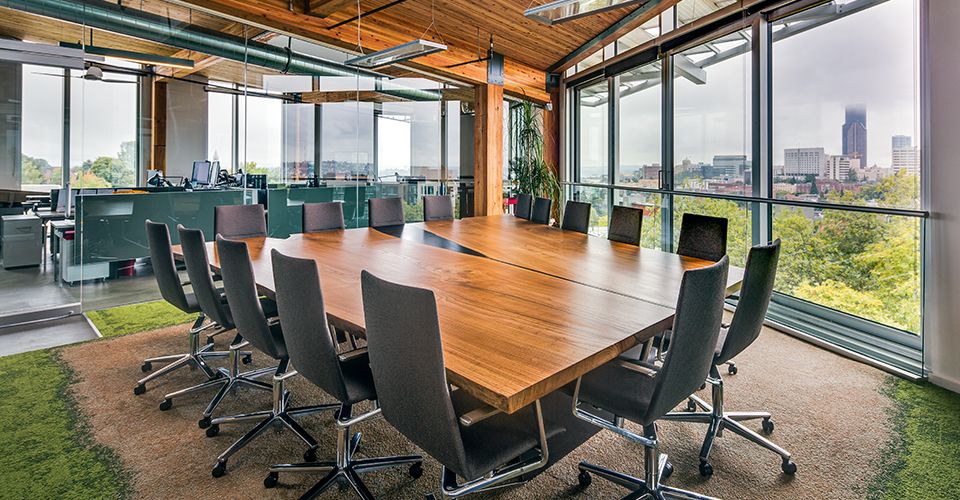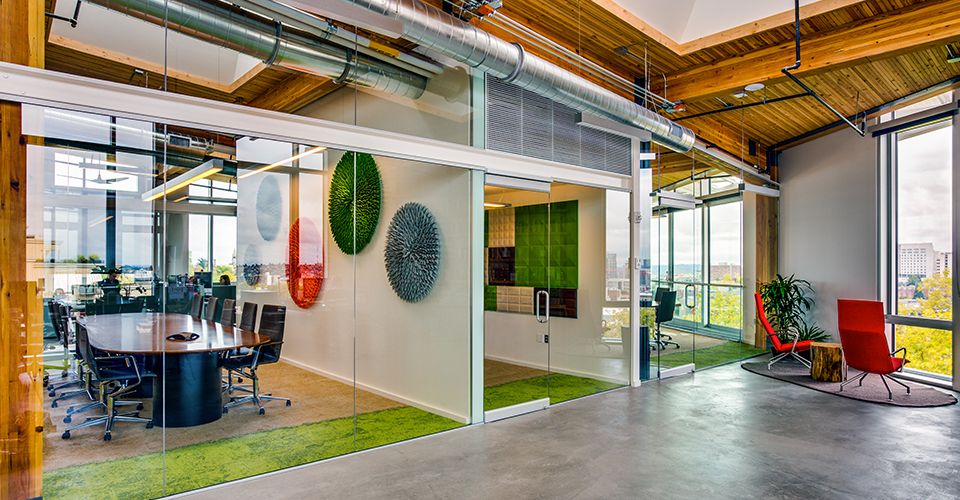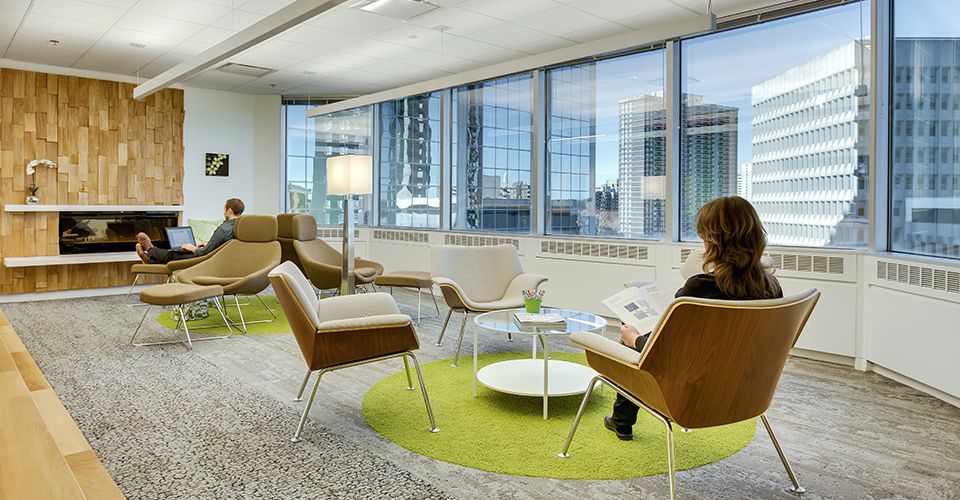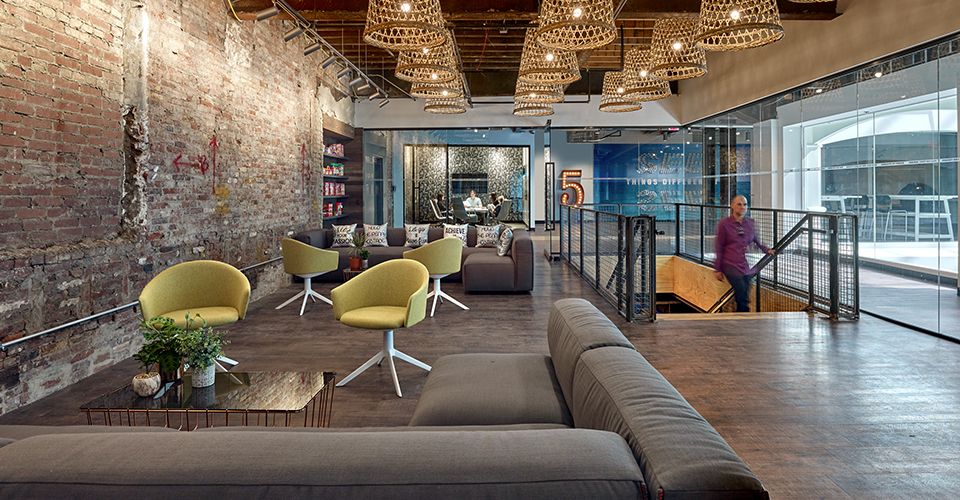Nearly 90 percent of our lives are lived inside built environments. Perhaps not so shockingly, up to one third of that time can be spent inside our workplaces.
Feel daunting? We can find some more optimistic news within the growing body of research that links the design of our built environments to impacts on our wellbeing. In an expanding number of cases, environments that integrate biophilic design can even optimize worker productivity and provide a subsequent return on investment for organizations.

© 2014 Brent Smith Photography
Why does biophilic design matter?
Imagine being in your favorite natural space. Maybe you envision sitting by the ocean hearing crashing waves, or maybe you, like me, remember a time when you climbed to the top of that towering pine tree in your childhood yard and read your favorite book for hours. Regardless of your unique memory, when you imagine being in your favorite natural spot, how do you feel?
Pause. Take a moment to really feel into that memory. The feelings you experience—and the resulting often positive emotions—can begin to describe the essence of what biophilic design strives to foster within the built walls of our day-to-day lives.
When we integrate biophilic design into our spaces (through natural elements, areas of refuge, curvilinear forms or fractals, etc.), we see a multitude of benefits supporting an increased quality of life. In his book Nature by Design: The Practice of Biophilic Design, the late Dr. Stephen Kellert provides an inspiring overview and deep understanding of potential strategies to create supportive, biophilic environments.
For architects, designers and building industry professionals, successful implementation of biophilic design lies in a thoughtful co-creative design process. It is through shared conversation with key stakeholders—often involving workshops and diverse-user engagement—that true understanding of the essence, sense of place, and unified goals of a project can be uncovered and successfully achieved within the framework of biophilic design.
Linking to the return on investment
The potential benefits of biophilic design go beyond enhancing wellbeing, extending to positive financial impacts for organizations. Terrapin Bright Green highlighted the potential vast economic benefits of biophilic design in their report, The Economics of Biophilia. In built environments with strong biophilic design attributes, Terrapin Bright Green documented impacts such as reduced illness and absenteeism, improvement in staff retention and even faster healing rates.
Furthermore, Terrapin Bright Green’s report outlines that often nearly 90% of a company’s operating costs can be linked to the people inside the organization when elements such as salaries, benefits and absenteeism are considered.

©2014 Brent Smith Photography
Let’s connect these key points of information.
We understand that people are often less stressed and perform better on memory and productivity tasks in spaces with biophilic design aspects. From Terrapin Bright Green’s research, we also understand that an organization can spend nearly 90% of its operating costs on its most valuable resource—people. When we connect these pieces of information, it highlights a potential profound impact on an organization’s financial outlook.
Understanding that there are many variables to consider when researching the impact our built environments have on quality of life, let’s quickly consider a thought-starter scenario. In this example, we can begin to connect the potential return on investment for a non-profit organization.*
Example Scenario
- $4,583,232 = Total Annual Expenses
- $3,190,225 = Annual Staff Costs
Employee salaries, benefits, and absenteeism (as measured in sick leave) add up to 60% of the organization’s annual expenses. In this scenario, if biophilic interventions in the built environment enhance just 3%*** of people costs for the organization, it could result in $95,706.75 in annual savings. From this process, we can understand the potential impacts biophilic design can have on us as individuals and within organizations.
Integrating biophilic design into projects
As industry professionals, understanding potential return on investment is an inspiring opportunity to integrate the deeper essence of biophilic design into our projects. Strategies such as facilitated biophilic design workshops, asking clients expansive questions around what their essence of place entails and utilizing common approaches can help us start that conversation. If you’re looking for a place to start, consider frameworks such as those listed within ILFI’s Biophilic Design Initiative, The Practice of Biophilic Design by Stephen Kellert and Elizabeth Calabrese, or Terrapin Bright Green’s 14 Patterns of Biophilia. Each can help you on your journey to integrate biophilic design into everyday spaces.
When achieved most successfully, biophilic design does not have a prescriptive look. It can successfully create or integrate into a variety of built environments from modern to traditional—and goes far beyond the application of greenery. Ultimately, biophilic design seeks to understand and integrate the deeper essence of a project’s sense of place while enhancing organizational purpose and, at its core, holistic wellbeing for all of life.
Footnotes
* It is essential to note that there are many factors impacting our wellbeing and productivity that are sometimes difficult to fully capture despite the most stringent processes being followed within research efforts. As such, it is recommended to be conservative when communicating potential benefits and possible connection of impact. The numbers in this exercise are merely an example to begin tying research information together in a scenario to understand potential impact for conversation advancement.
** A non-profit is used in this scenario, as its operating costs are lower than the researched average for companies. We have done so to reinforce a conservative approach with the numbers, further validating the potential impact.
***Some studies have linked impact of built environment designed with biophilic approach to have anywhere between a 6–16% people costs. Using 3% allows us to continue the approach of being conservative with our calculations of impact.
Featured image © 2018 Eric Laignel



2 responses to “Biophilic Design — Good for You, Good for Business”
We are KRI Inc., a consulting firm, in Japan.
We are now pursuing the examination on “Biophilic design office” together with a company, that is one of the largest housing and office manufacturers in Japan.
Your publication, “The Global Impact of Biophilic Design in the Workplace, published 2015”, is extremely impressive for us.
It gives a lot of valuable information and suggestions which would be useful for our business development.
The publication indicates that “Workers in office environments with natural elements, such as greenery and sunlight
– report a 15% higher level of well-being
– are 6% more productive and
– are 15% more creative.”
Would you provide us with references or your own data as the proof of the above numerical values, if possible?
Indeed, we could not find such data in the literatures shown in the publication.
We would like to learn more deeply about the effect of the biophilic design.
Thank you for your kind support in advance.
Mr. Kuromoto,
We are so excited to see your interest in the positive effects of biophilic design and are glad you found the Global Human Spaces Report valuable.
The report itself serves as a summary of existing literature on the topic as well as original research conducted by Sir Cary Cooper. We suggest you reach out to Robertson Cooper. They might be able to share more details on the references and data.
Thank you,
Interface